Motorhome advice: Building your own campervan
Words and photos by Peter Rosenthal
When it comes to DIY campervan conversions, it’s fair to say that not all are created equally. They’re not always as neat and tidy as a professional conversion and wonky panels and misaligned screws are common. This isn’t a criticism of DIY conversions – it’s massively difficult to build a campervan and we’re full of respect for anyone who tackles one. But it’s natural for there to be variations in the quality of self-builds – we all have differing standards and differing levels of ability and equipment.
So, when Martin Senior got in touch about his self-built Ducato conversion, we were excited - it looked so well executed in the photos he emailed us. Martin’s background is in electrical engineering, and his looked a much more polished creation than we’d expect from a fully self-built campervan. But would it live up to a closer inspection? To find out, I headed up to his home in Yorkshire to take a closer look...
A background in engineering
As soon as I stepped on board it was clear that something was amiss. Suspecting he was in the trade and trying to pass off his work as a DIY build, I dug a little deeper - this seemed far too good to be an amateur’s first attempt. It turns out that Martin has spent the last 40 years as a chartered electrical engineer running all manner of engineering teams. Clearly, he’s not your average bloke tackling a weekend DIY task.
Martin retired two years ago and his wife a year later, so it seemed the ideal time to enjoy their retirement cruising around in a campervan.
“As my background is in electrical engineering and design engineering and I have access to an industrial CAD (computer aided design) system, I’ve got plenty of experience of taking things from a blank sheet of paper to a completed design, so it seemed like a good idea to build my own van,” he explained.
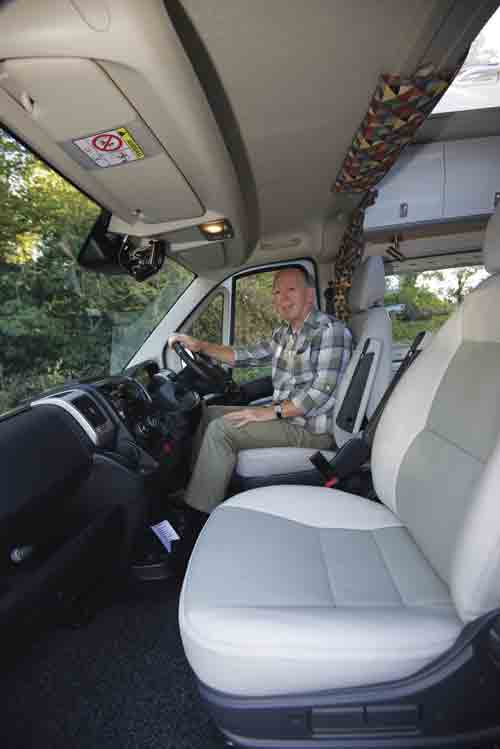
The campervan wishlist
“Of course, I went to motorhome shows first to see what I could buy. We didn’t want a massive one – a 5.99m Ducato was all we wanted – but I looked around and thought that for my £45,000, I could do a better job myself. I’ve got the time, I’ve got and skills and the kit.”
“It all boiled down to being a straightforward design job: how do you pack everything in? We wanted a full-sized bed, a decent place to sit, somewhere to watch the telly, a big kitchen and a washroom big enough to shower in. Nobody seemed to be offering this. Plus, if you went for one with a rear lounge, they didn’t seem to have much storage as you didn’t get a garage or a proper boot that you can stick a bike in. We also didn’t need to have four berths, as it’s just the two of us.’’
With this in mind, Martin took to his CAD system, having obtained a reasonably accurate 3D drawing of a Fiat Ducato.
“I soon realised that the space is all about compromise and to get the full-sized bed in place, we’d need to compromise and make a section of it fold up.”
Rather than simply make a fold-up section of bed, though, Martin cleverly engineered the bed base to flip through 180 degrees to form an extra area of worktop on its underside.
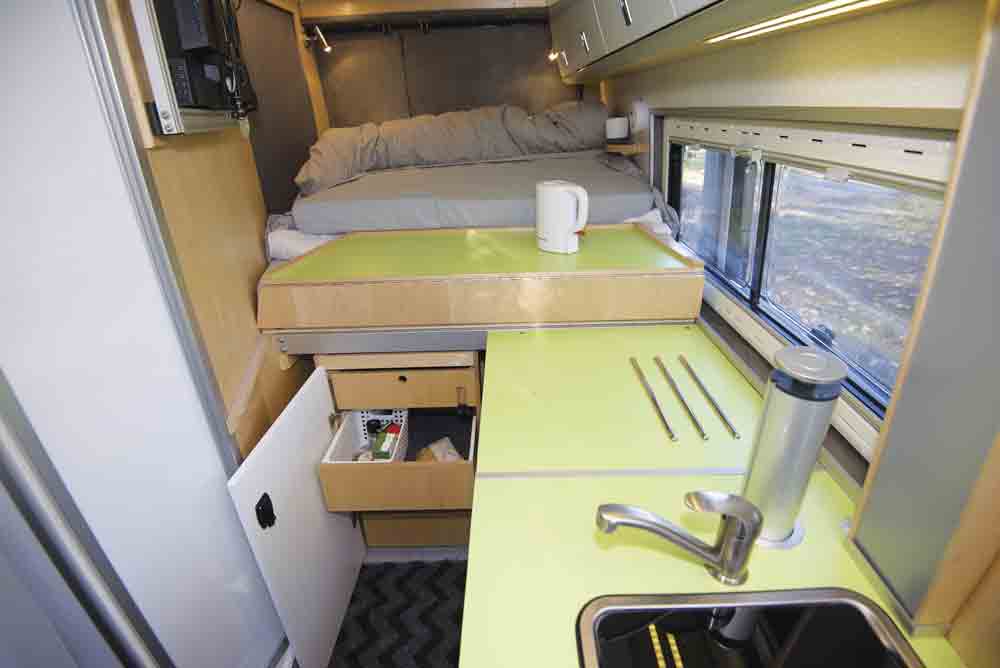
“I did think about running the bed transversely,” he added, “but I didn’t think it worked as well because of the packaging around the wheelarches.”
With his layout, Martin has managed to fit a Truma Combi 6 blown-air heater and boiler above one wheelarch and a habitation air-con system above the other wheelarch. “The air-con fitment involved some really fancy ducting,” he grinned, “but I didn’t want it roof-mounted.”
With these major appliances tucked out of view and a clever services space located behind the central washroom, Martin managed to free up plenty of interior space in the design, and used this to fit seven high-level lockers, a large wardrobe and a decent-sized luggage space. And yes, it can take a couple of folding bikes together with a set of outdoor chairs and various other outdoor gubbins.
The actual layout features a longitudinal bed that’s mounted alongside a spacious washroom that has the toilet sited above the wheelarch. To get around the dangling leg issue, Martin added a fold-down flap.
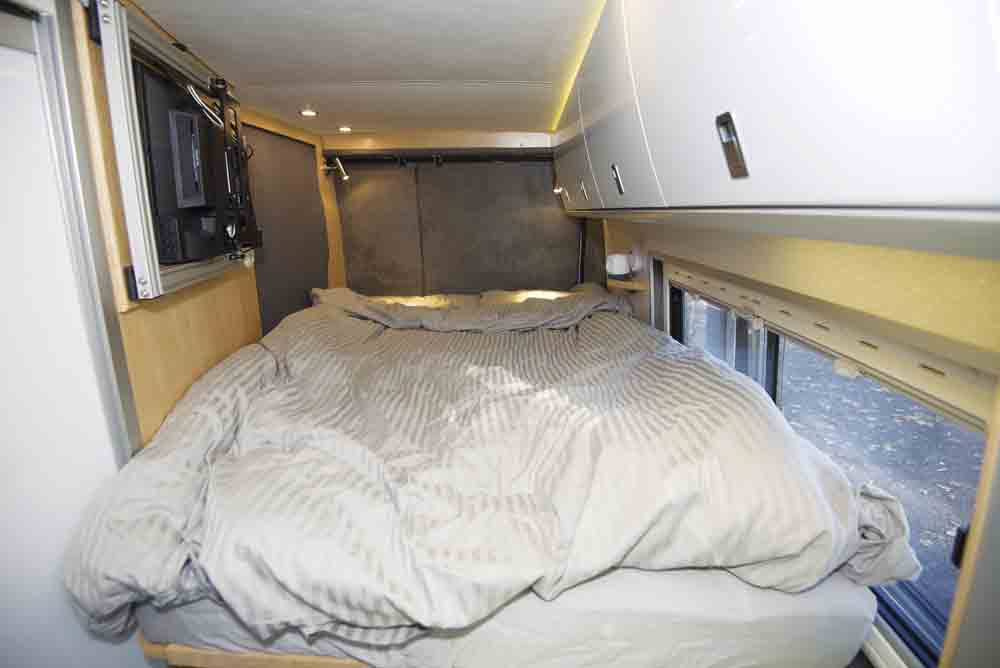
An equal amount of ingenuity has gone into creating the kitchen layout, which features an 80-litre three-way fridge that is linked to a clever ducted fan system to maximise its cooling efficiency in warm weather (Martin has fitted it with sensors inside the fridge and externally to monitor the air temperature so that a trio of fans can be automatically triggered).“I actually did some temperature tests of the fridge and found it took all night to drop the temperature down from 13 degrees to 6 degrees, when you’ve filled it full of food.”
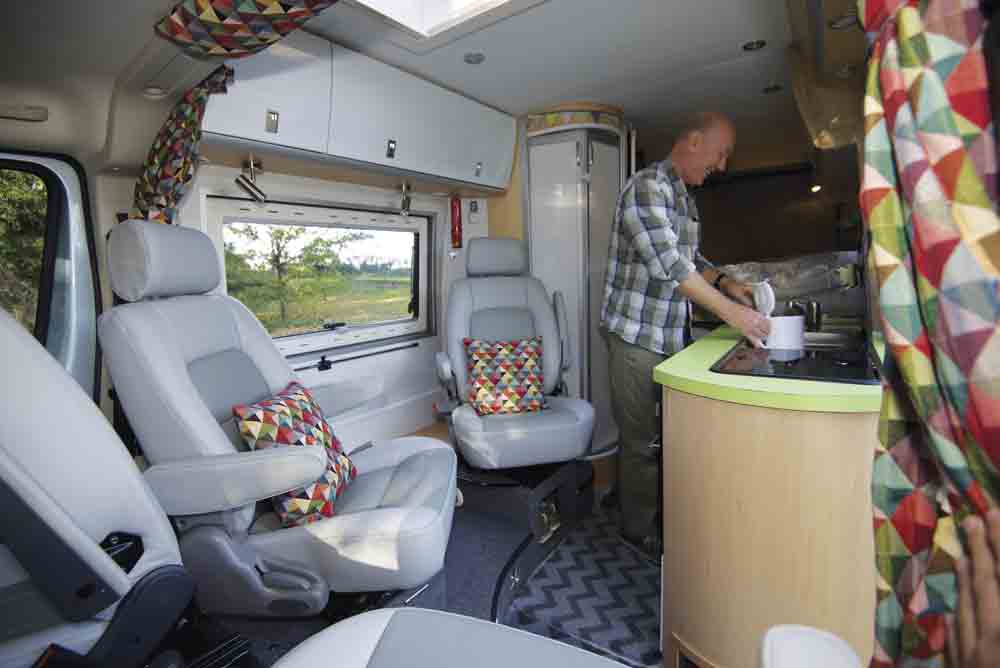
Built to order panel van
The panel van itself was built to order for Martin and Fiat initially quoted nine months to build it. Happily, his local Fiat dealer waded in and this was reduced to a mere three months, instead.
The actual spec of the 2.3-litre 180bhp Comfort-Matic LWB Ducato Maxi also includes heavy duty rear springs, uprated alternator and all-season tyres, as well as the Business Pack option (cab air-con, alarm, reversing sensors, cruise control and variable speed limiter). He didn’t opt for the Fiat sat-nav system though – he fitted his own.
Why a Fiat? Well, there wasn’t a lot of choice. “Firstly, it had to be an automatic and it also had to be big enough to fit everything in,” Martin said. “I think if I had to do it again I’d seriously consider a Ford Transit. At the time, though, the Ford wasn’t available in auto and all the other cars we have are automatic, so it was a must.”
“The Mercedes has an auto but it’s horribly expensive, prone to rust and the body shape isn’t that helpful, as it tapers towards the roof. And while Renault does an automatic on the Master, it wasn’t big enough. The extra width of the Fiat makes such a difference.”
Martin had actually spent about two years planning and designing the campervan, so when it turned up it was a case of measuring the actual van against the plans and tweaking the design as needed where there were slight differences. The actual fabrication process is clearly another of Martin’s strengths and, as he’s also a keen car enthusiast, he already had all the necessary tools, too.
After about a year of work the van was finished to the point where it was usable, with the complete build taking a further six months. “I worked on it every week day during that time,” he said. “As my wife hadn’t yet retired I was home on my own, so it seemed an ideal way to spend the time.”
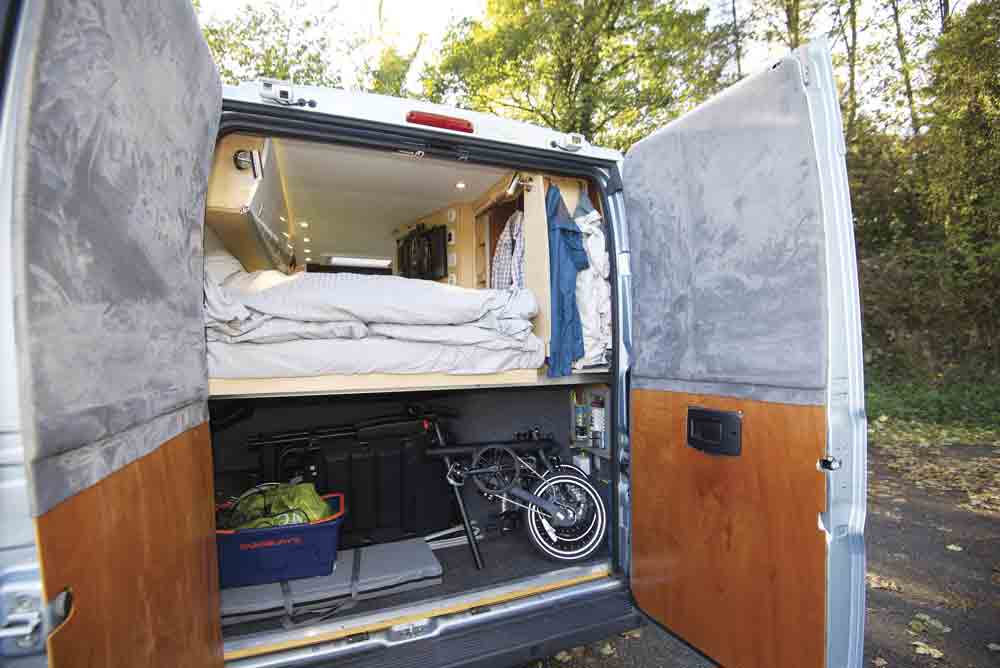
Testing, testing, testing
“For our first trip, we took our campervan up to a site in Northumberland, deliberately picked as it wasn’t too far away and would be ideal for testing it out. We found that the fridge cooling wasn’t working properly, so I had to modify the ducting. But, other than that, everything seemed to work.”
Encouraged by this test trip, for their second trip they decided to travel a bit further and leave the UK, heading to France to visit Martin’s brother in Normandy. “We toured around ACSI sites for two and a half weeks and it all seemed fine.”
There was a trip to Amsterdam – staying in a riverside campsite in Delft – followed by a tour of northern Germany and Martin found this one far more relaxing as it wasn’t a snagging trip: “We already knew everything worked so I could just enjoy the holiday.”
So what trips does Martin plan next? When we spoke, southern Spain in the spring and Scotland in the summer were on the list. “I’d also like to go back to Norway and Sweden, where I’ve been before,” he said. “We’re keen to go a bit further, too, maybe down to Istanbul.”
The final verdict
Would he build another campervan? Martin isn’t so sure. “This one did take over my life a bit and my wife just wants to enjoy using a campervan,” he reflected. “The one thing that is worth mentioning is the Self Build Motor Caravanners Club proved really useful and its forum has been exceedingly useful for asking questions about the build. I’d recommend any self-builders to join. It’s not all about high-end builds, even if you just want to bolt some wood panelling to
the walls of your campervan, you’d be made very welcome by the club.”
The thing that stands out about Martin’s vehicle isn’t the clever layout, it’s the way in which it’s been built. Coming from an engineering background and building a campervan with fresh eyes has meant that it has many unique features.
The control panel is one of these and features immaculately labelled push buttons with bezels that illuminate when activated. The controls for the lighting are all grouped together logically, as are all the controls for the water systems, making it intuitive to use.
Things get even more impressive when you look behind any of the control panels and see the quality of Martin’s wiring – his electrical background is very obvious, as every circuit uses a fuse and a relay, and the wiring runs are all in professional conduit.
It’s a delight to see something done this well – few professional campervans have wiring this neat, let alone self builds!
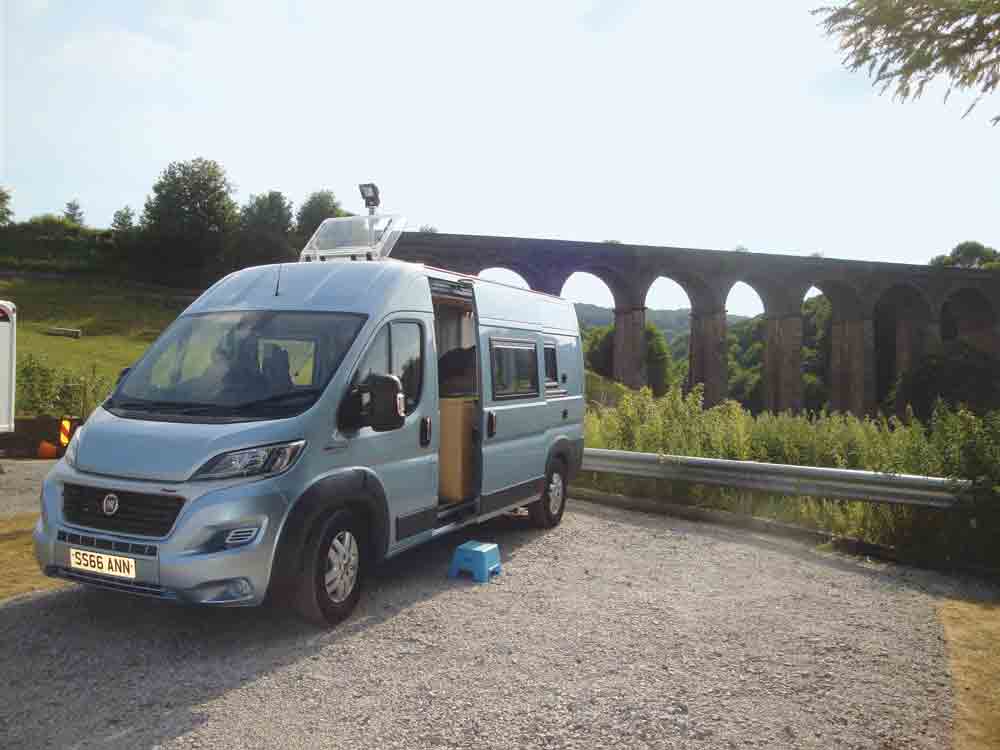
The details
Base vehicle: 2016 Fiat Ducato LWB Maxi chassis
Conversion type: Hand-built self-conversion
Owned since: 2016
Drive: Front-wheel drive
Engine: 2.3-litre turbo diesel (Euro 6)
Power: 180bhp
Economy: 30mpg (estimated)
Gearbox: 6-speed automatic
Travel: 3
Berths: 2
Leisure battery: 2 x 150Ah
Payload: 800kg (estimated)
Length: 5.99m
Width: 2.08m
Height: 2.60m
The costs
The van, built to order: £27,000
The conversion: £18,000
Total costs to date: £45,000
Useful contact
Self Build Motor Caravanners Club
This feature was originally published in the June 2019 issue of Campervan magazine - click here to buy a digital edition.








Recent Updates
Engine management lights: all you need to know
What is the engine management light? What does it mean, and what do I have to do? ...
Motorhome air suspension: all you need to know
Motorhomes are heavy and the additional weight of equipment and height of the bodywork can increase the loads ...
Motorhome WiFi: how to get better motorhome internet
Staying connected on the move is more and more essential, so relying on campsite WiFi isn't an option – here ...
A class of their own - our guide to A-class motorhomes
Thinking of trading up to an A-class, or even going straight to the top of the motorhome tree? We guide you ...
Explore overseas on a motorhome dream tour
Enjoy exotic travel in a campervan or motorhome by hiring, swapping with someone else or exporting your ...
Motorhome water systems: everything you need to know
On-board water is an important part of every motorhome – here’s everything you need to know ...
Campervanning in Europe: what you need to know
Whether you're planning a leisurely drive through the French countryside, navigating bustling city streets in ...
Campervan security: all you need to know
With thefts on the increase, it’s important to know how to keep your campervan secure and prevent campervan ...
Campervan furniture: everything you need to know
Our campervan experts guide you through all the essentials for your campervan, including tables, chairs, ...
Campervan finance: how to fund your purchase
Here we look at the different types of campervan finance available, to help you decide what’s the best option ...
Other Articles
Britain’s best used motorhomes
Want a great motorhome without paying the premium for a new one? Here's a guide to the best you can get in the pre-owned market for each layout, ...
Which motorhome? Choosing the perfect motorhome for you
Choosing a motorhome or campervan is one of the biggest buying decisions you’ll ever make, so it's important ...
Campervan washroom essentials: stay fresh on the road
Our guide will take you through the campervan washroom essentials you'll need so you're well-prepared for ...
Dogs in campervans: all you need to know
Follow our advice and your dog will enjoy campervanning as much as you do ...
Electric campervans: all you need to know
Our guide will take you through everything you need to know about electric campervans and what the future ...
Motorhome electrics: a complete guide to your motorhome electrical set-up
Motorhome electrics can dramatically enhance the convenience and comfort of your vehicle – but they can be ...
Lighting for campervans: all you need to know
We guide you through all the lighting options available for you and your campervan, including interior ...
Electric bikes for motorhomes: our ultimate guide
Read our comprehensive guide to electric bikes for motorhome owners, helping you add electric power to your ...
Our guide to 'cheap' motorhomes in 2024
If you're on the hunt for an affordable new motorhome, this is the best place to start – we've rounded up a ...
Campervans in winter: all you need to know
Here's your guide to preparing your campervan for the colder months, whether you will be using it or putting ...